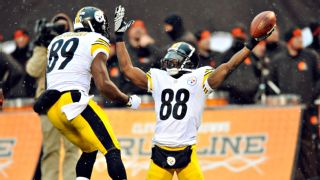|
When the Denver Broncos prepared themselves for free agency, they did what any team in the supply and demand business of roster spots would do: The decision-makers looked at their free agents and assigned each a value. Then executive vice president of football operations/general manager John Elway said those free agents would be allowed to test the market. And what that often really means is the team believes those players will get more in the open market than it would be willing to pay to keep them. That turned out to be true for guard Zane Beadles as well as running back Knowshon Moreno and it really turned out to be true for wide receiver Eric Decker. Decker got a five-year, $36.25 million deal from the New York Jets that includes $15 million guaranteed. The Broncos then signed Emmanuel Sanders, the player who at the moment is Decker's replacement, to a three-year, $15 million deal. The Broncos see Sanders as a more versatile, more athletic player overall than Decker, one who can play both outside and in the slot. Decker did play in the slot at times in his tenure with the Broncos, but the current regime saw him as an outside receiver only. Sanders has quick-twitch ability with the ball and creates missed tackles with the hope of more catch-and-run yardage. Both he and Decker have had difficulties at times with drops. But the coming season may, or may not, show how much of Decker's emergence as a receiver with back-to-back 1,000-yard, double-digit touchdown seasons had to do with playing in an offense with Manning. And for his part Sanders will have the chance to show if he can go from a guy whose top two seasons have been 626 yards in 2012 and 740 yards in 2013 to something more. Manning got his first up-close look at Sanders in recent workouts at Duke University -- where Manning's long-time friend and former offensive coordinator at Tennessee, David Cutcliffe, is head coach. By all accounts Manning came away feeling good about Sanders' potential in the offense. Or as Manning put it Wednesday morning, before he spoke at a fundraising breakfast for the Boy Scouts at the Pepsi Center in downtown Denver: "I had a chance to throw with Sanders down there in North Carolina and I'm excited about playing with him." At first blush unless the Broncos add a bigger receiver in next month's draft, they are smaller, as a group, with the Sanders-for-Decker swap. Decker is 6-foot-3, 214 pounds as compared to Sanders' 5-11, 180 pounds. Since Manning's arrival two years ago, defensive coordinators routinely talked about the difficulty in matching up with Decker, Demaryius Thomas (6-3, 229) and tight end Julius Thomas (6-5, 250) in the red zone where Manning can put the ball up for his guys to go get it. That was particularly true from the doorstep with five of Decker's 11 touchdown catches this past season were for three or fewer yards. The Broncos hope, however, Sanders can win some of those battles with quickness to give Manning the room/opportunity to throw to him in the more confined spaces once the Broncos' offense is inside the opponents' 15-yard line. Whether he was running across the formation or worked to the side where he lined up, Decker's catches were fairly well dispersed all over the field this past season. He made 34.5 percent of his catches to the offensive right, 41.4 percent to the offensive left and 20.7 percent in the middle of the field. Sanders, too, would project a similar dispersal given his ability to line up anywhere the Broncos want him to in their three-wide look. The Broncos, though, believe Sanders can do even more after the catch even as the Broncos receivers led the NFL in that category overall last season. Decker had 47 percent of his catches go for 10 or fewer yards last season, 69 percent for 15 or fewer yards. The Broncos hope Sanders can push a higher percentage of his catch-and-runs toward bigger yardage totals, but for Sanders' part he will have to be ready to play more snaps than he has in the past. Decker was in the 1,000-snap club last season -- 1,050, or 87 percent of the Broncos plays -- and had 15 games when he played at least 50 snaps. Only Thomas played more than Decker (1,106 snaps) among the Broncos' pass-catchers. Wes Welker played 770 snaps, or 63.8 percent of the plays, before missing games down the stretch with a concussion and Julius Thomas checked in at 901 snaps (74.6 percent). The Broncos threw more than the Steelers did in '13, 675 pass attempts as compared to the Steelers' 586, and Sanders played at least 50 snaps in nine of 16 games last season. When the Steelers still had Mike Wallace in 2012, Sanders played at least 50 snaps in five games. Sanders has played in 16 games in each of the last two seasons, but has never started more than 10 games in any season of his career. But if things go as the Broncos want, and need them to go, he'll certainly have the chance to change that this time around.
|

